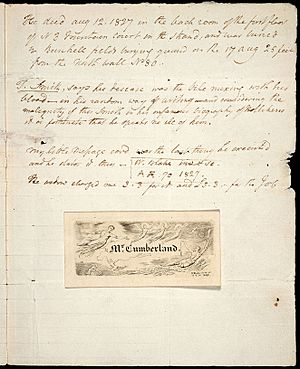George Cumberland facts for kids
Quick facts for kids
George Cumberland
|
|
|---|---|
| Born | 27 November 1754 London
|
| Died | 8 August 1848 (aged 93) |
| Nationality | English |
| Occupation | Art collector, writer, poet, printmaker, watercolourist |
George Cumberland (born November 27, 1754 – died August 8, 1848) was an English art collector, writer, and poet. He was a very close friend and helper of the famous artist William Blake. Like Blake, George Cumberland loved to try new ways of making prints. He also enjoyed painting with watercolors and was one of the first artists to join the Bristol School group. He used his many friends and connections to help other artists, especially Edward Bird and Francis Danby.
Contents
Early Life and Art
George Cumberland was born in London in 1754. His father was also named George. For many years, from 1769 to 1785, he worked as a clerk for an insurance company.
In 1772, he also started studying at the Royal Academy Schools. He showed his art there in 1782 and 1783. However, he was not chosen to become a full member in 1784. Because of this, he didn't think highly of the Academy and wrote essays criticizing it.
Friendship with William Blake
Around 1779, George Cumberland became friends with William Blake. Blake was also a student at the Royal Academy Schools. Their group of friends included other artists like John Flaxman and Thomas Stothard.
Cumberland was a lifelong friend and supporter of Blake. As early as 1780, he wrote an article praising Blake's first art show. He often tried to find people who would buy Blake's art. For example, in 1798, he tried to get John Horne Tooke to hire Blake to engrave pictures for his book.
Cumberland and Blake both loved experimenting with printmaking. In 1784, they tried new ways to print words that were etched onto plates. Cumberland even wrote about his "New Mode of Printing" that year. He often asked Blake for advice on how to print using metal plates and lithography.
Adventures in Italy
In 1784, George Cumberland received some money that allowed him to stop working. From 1785 to 1790, he traveled around Europe. He spent most of his time living in Rome, Italy. He also visited Paris and Florence.
In Rome, he met many other artists. He studied the works of famous artists like Raphael and engravers such as Marcantonio Raimondi. He collected many prints and art objects, especially a large number of engravings by Giulio Bonasone.
The Bristol School of Artists
In 1803, Cumberland moved to Weston-super-Mare in England. Then, in 1807, he moved to Bristol, where he lived for the rest of his life. He became one of the first members of a group of artists known as the Bristol School.
This group often went on trips together to sketch the beautiful scenery around Bristol. Cumberland's daughter, Eliza, and his son, George Jr., sometimes joined these trips.
Helping Other Artists
Cumberland believed that artists should paint directly from nature. His watercolor paintings were similar to those of his friend John Linnell. It was Cumberland's son, George, who introduced Linnell to William Blake in 1818.
Cumberland became a close friend of Edward Bird. He couldn't give Bird money, but he would lend him items from his art collection to study. In 1814, Cumberland helped Bird get a special art job for the Prince Regent. When Bird died in 1819, Cumberland successfully asked the Royal Academy to provide money for Bird's wife.
Cumberland helped many Bristol artists by recommending them to his important friends. In 1820, he helped promote Francis Danby's painting, The Upas Tree of Java. In 1822, when Danby and other artists planned to visit London, Cumberland made sure that famous artists like Thomas Lawrence and Thomas Stothard knew they were coming.
Cumberland often suggested ideas for Danby to paint. It's thought that Blake's influence might have reached Danby through Cumberland. For example, Danby's painting Disappointed Love (1821) reminds people of Blake's Songs of Innocence and of Experience.
Cumberland owned many of Blake's important books and prints. He had early copies of The Book of Thel and For Children: The Gates of Paradise. He also had copies of America a Prophecy, Europe a Prophecy, The Song of Los, Visions of the Daughters of Albion, and Songs of Innocence and of Experience.
William Blake died in 1827. The very last engraving Blake made was a visiting card for Cumberland. Blake decorated the card with figures representing the Seasons, including children playing with hoops and flying kites.
Later Years
George Cumberland was also interested in fossils. From 1810, he was an honorary member of the Geological Society. In 1826, he published a book about some fossil sea creatures called encrinites.
In 1827, he published a book about collecting old Italian engravings. He later gave his art collections to the Royal Academy and the British Museum.
Cumberland's wife, Elizabeth, passed away in 1837. George Cumberland died on August 8, 1848, in Bristol. They were both buried at St George's Church, Brandon Hill. They had two sons, George and Sydney, and three daughters, Lavinia, Aurora, and Eliza.


